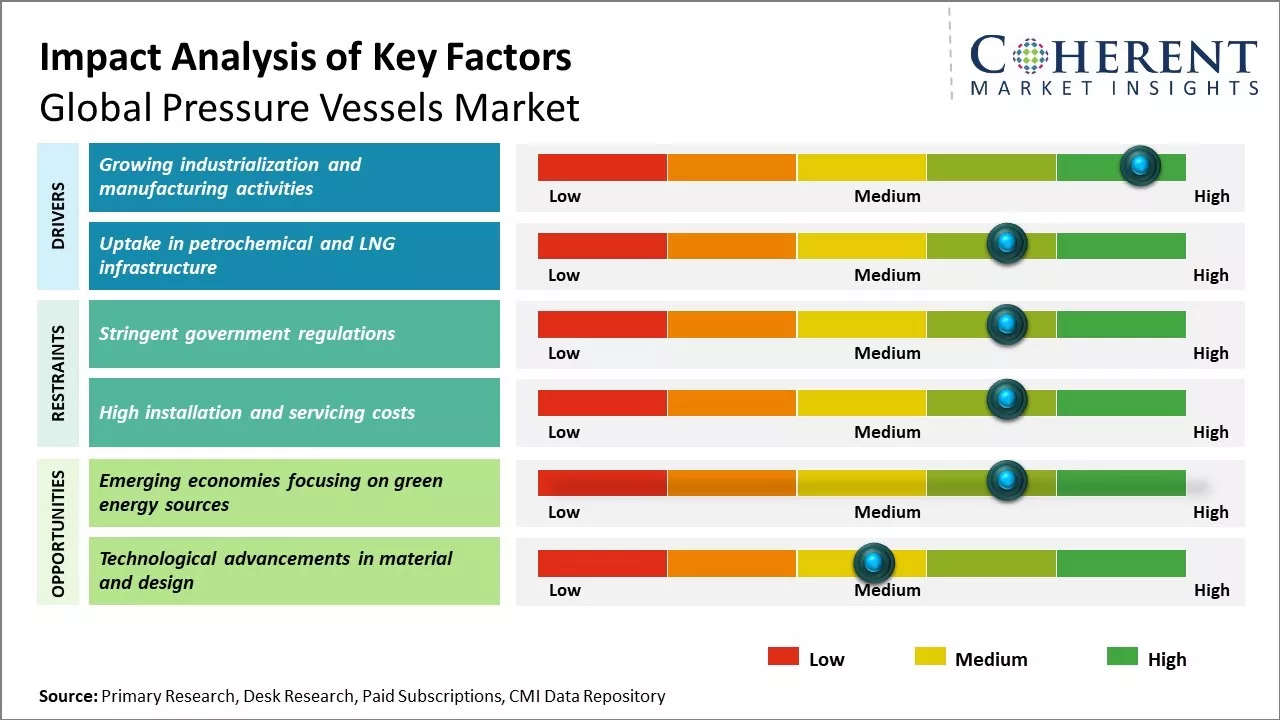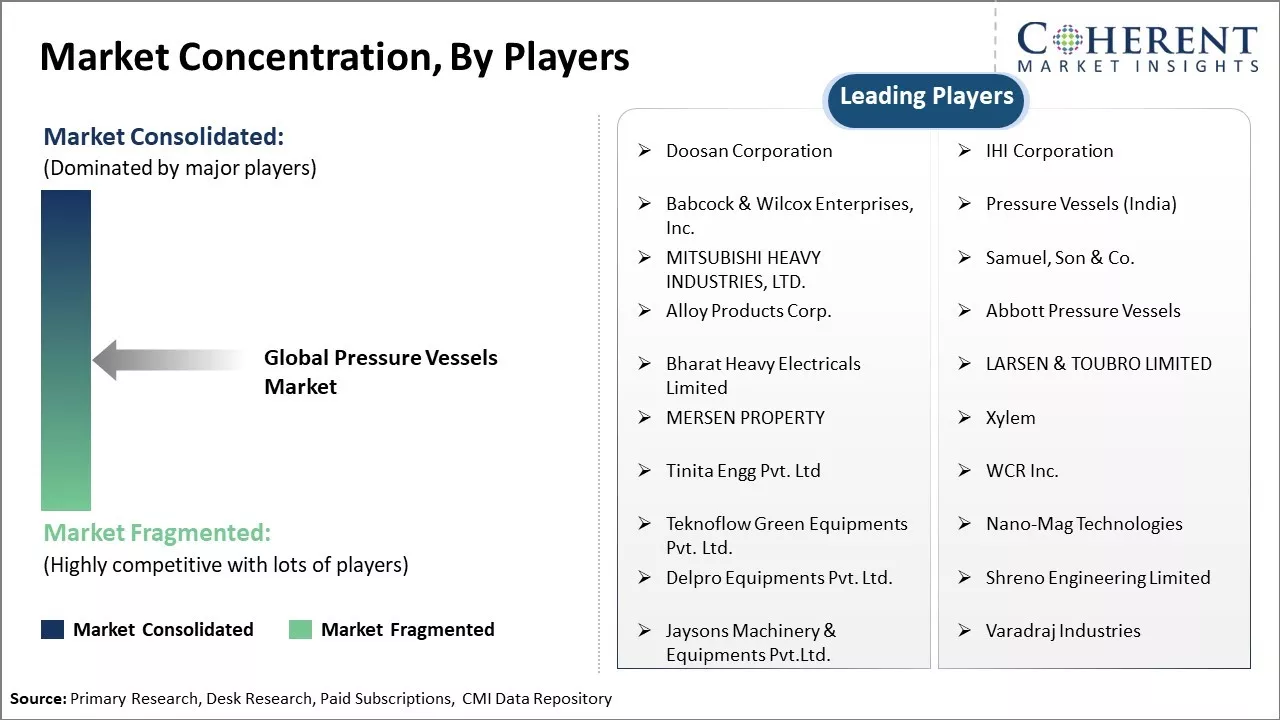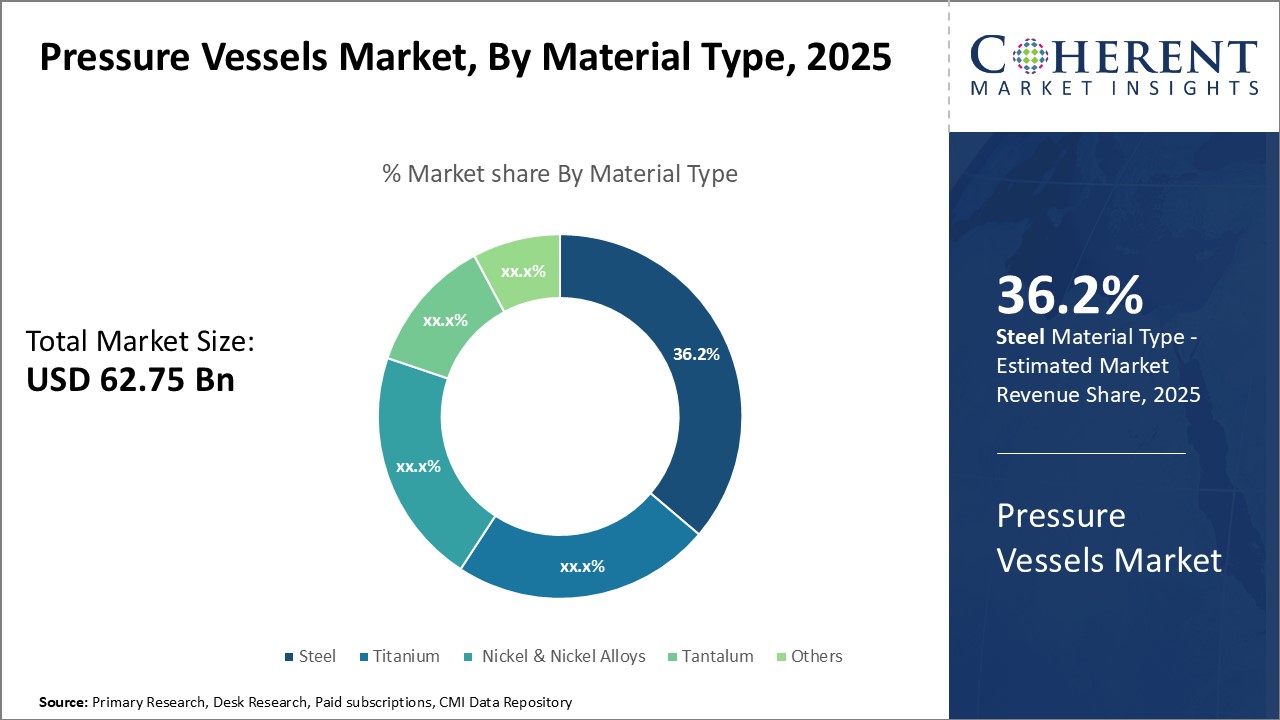Pressure Vessels Market Size and Trends
The pressure vessels market is estimated to be valued at USD 62.75 Bn in 2025 and is expected to reach USD 82.08 Bn by 2032, exhibiting a compound annual growth rate (CAGR) of 3.9% from 2025 to 2032.

Discover market dynamics shaping the industry: Download Free Sample
The pressure vessels market is driven by the expansion of oil and gas industries. Pressure vessels find major applications in various industries such as oil & gas, chemicals, and power generation among others. With rising energy demands globally, the oil and gas industries have been expanding rapidly. This is positively impacting the growth of the pressure vessels market. Additionally, strict regulations regarding safety of boilers and pressure equipment across regions are compelling industries to replace aging pressure vessels which is further propelling the demand for pressure vessels. Growing investments in setting up new power generation facilities, mainly coal-fired and nuclear are also driving the market growth.
Growing industrialization and manufacturing activities
With the growing industrialization and increasing manufacturing activities across various industries such as oil and gas, chemical and petrochemicals, and power generation, there is a rising demand for pressure vessels. Pressure vessels are essential equipment used in various industrial processes to store, transport and process chemicals, oil, gases and other substances under high pressure. They are used extensively in crude oil refineries, natural gas processing, transportation plants, petrochemical units, steam generator boilers, nuclear power plants, and other manufacturing industries.
Over the past few years, there has been significant capital expenditure by both public and private players to expand existing manufacturing facilities as well as set up new plants. Various countries are focusing on boosting domestic manufacturing through initiatives such as Make in India, Industrial Transformation Programs, tax benefits, and relaxed regulations to encourage local production and reduce imports. This has provided a major push to industries that utilize pressure vessels on a large scale. Furthermore, continuous technological advancements have enabled higher operating pressures and temperatures in industrial processes. This has augmented the demand for advanced pressure vessels that can withstand wider ranges of pressure and temperature. With growing investments planned in process industry verticals across major economies, the requirement for pressure vessels is likely to surge in the coming years.
Market Concentration and Competitive Landscape

Get actionable strategies to beat competition: Download Free Sample
Uptake in petrochemical and LNG infrastructure
Another key driver for the pressure vessels market is the increasing investments in petrochemical industry infrastructure as well as liquefied natural gas (LNG) supply chain worldwide. Petrochemicals being pivotal to the manufacturing of numerous industrial and consumer products, their production is witnessing a massive expansion globally. Several companies are initiating large grassroots petrochemical complexes as well as expanding or debottlenecking existing facilities especially in the Middle Eastern and Asian countries. Since pressure vessels have widespread application in the petrochemical industry for reacting, storing, and transporting chemicals, this sector promotes heavy demand for these equipment.
Similarly, with natural gas emerging as a transition fuel and its rising consumption, countries are developing new LNG import terminals and expanding regasification facilities. Many nations are also increasing indigenous LNG production through new liquefaction plants. The LNG value chain from production to transportation requires extensive use of cryogenic pressure vessels and cryogenic storage tanks. As both petrochemical and LNG infrastructure develops on a global scale, it will substantially drive the sales of pressure vessels in the coming years.
Key Takeaways from Analyst:
The pressure vessels market is expected to grow at a steady pace driven by increasing demand from the oil and gas, power generation, and chemical industries. The need for storing fluids, gases and thermal energy at high pressures will drive the demand for pressure vessels globally. The oil and gas industry dominates the market and is expected to remain a major end-user. North America remains the largest market however Asia Pacific region is likely to witness fastest growth led by China and India.
Factors like stringent safety regulations and certification standards could pose short term challenges for manufacturers. Substitutes like small scale LNG carriers and floating storage units (FSRUs) could also restrain the market growth to some extent. However, increasing global energy demand along with investments in nuclear and carbon capture technologies will open new opportunities. Modernization and upgrade of aging infrastructure in developed markets of Europe and North America also presents an opportunity area.
Advancements in materials and fabrication technologies are allowing vessels to withstand higher pressures and temperatures. Increased uptake of customized and digitally-engineered vessels by end-users can further stimulate demand. Greater emphasis on renewable energy adoption may reduce dependency on fossil fuels marginally affecting market prospects. However, growing chemical processing, desalination, and waste treatment industries would counter balance this impact.
Market Challenges: Stringent government regulations
Stringent government regulations are imposing major restraints on the growth of global pressure vessels market. Pressure vessels are critical equipment used across many industries like oil and gas, chemicals, power generation etc where safety is of paramount importance. Government regulations play a vital role in ensuring the safety standards are met through stringent design, material and operational guidelines. However, over the past few years many countries have further tightened the regulatory norms to avoid any catastrophic failures. For example, in European Union, the Pressure Equipment Directive 97/23/EC was amended in 2014 with more rigorous technical requirements for design, manufacture, testing and conformity assessment procedures. Similar revisions have been done in international standards like ASME and ISO as well. This has increased compliance burden on equipment manufacturers. The approval and certification process has become lengthier and complex which is delaying the time to market for new products.
Market Opportunities: Emerging economies focusing on green energy sources
Emerging economies worldwide are increasingly focusing on developing green and renewable energy sources to power their future economic growth in a sustainable manner. This shift towards clean energy presents a massive opportunity for growth in the global pressure vessels market. As developing nations across Asia, Africa and Latin America undertake large scale projects in solar, wind, hydro and other renewable energy generation, there will be a huge demand for pressure vessels to support these green initiatives. All green energy systems such as solar thermal plants, geothermal installations, biomass gasifiers require extensive networks of pressure vessels to function efficiently and move energy across grids. For example, a concentrated solar plant may need thousands of pressure vessels to store thermal energy in its heat transfer fluids. Similarly, biogas projects involve multiple pressure rated vessels for various stages of anaerobic digestion of biomass and storage of processed fuel.

Discover high revenue pocket segments and roadmap to it: Download Free Sample
Insights by Material Type: The Strength and Versatility of Steel Drives its Dominance in the Pressure Vessels Market
In terms of material type, steel is expected to contributes 36.2% share of the market in 2025, owing to its unique combination of strength and versatility. Steel offers an excellent balance of mechanical properties for applications requiring high strength and resistance to corrosion under pressure. Its plasticity allows for complex shapes to be formed during manufacturing without compromising integrity. This moldability gives designers more freedom to optimize vessel designs. Steel also has a long history of safe and reliable usage, so its material properties and performance characteristics are very well-understood. This track record helps reduce design risks and validation costs. Perhaps most importantly for industrial customers, steel is widely available from numerous global suppliers at competitive price points. Its economies of scale give steel a cost advantage over specialized alloys. As a result, steel remains the default choice for applications not imposing stringent weight or temperature constraints, capturing the largest segment.
Insights by Product Type: Boilers Dominate as Pressure Vessels due to Broad Applicability in Power Generation and Industrial Heating
In terms of product type, boilers is expected to contribute 40.8% share of the market in 2025 due to their broad applicability across power generation and industrial heating applications. Boilers are designed to generate high-pressure steam by burning fossil fuels like coal, natural gas, or fuel oil. This versatility makes them suitable for diverse needs like electricity production in utilities, steam provision in oil refineries and petrochemical plants, and district heating networks. Their steam output can also be easily modulated to dynamically match fluctuating thermal loads. Beyond power and process needs, boilers also see demand for boiler-fed sterilizers in pharmaceutical manufacturing and laundries. As a long-established technology fulfilling heating requirements globally, boilers have entrenched themselves as the dominant pressure vessel product type.
Insights by End User: Chemicals Sector Predominance Results from the Integral Role of Pressure Vessels in Manufacturing Processes
In terms of end user, the chemicals & petrochemicals sector is expected to contributes 32.8% share in 2025, due to the integral role pressure vessels play in numerous chemical manufacturing processes. Reactors, separators, distillation columns, and other unit operations within chemical plants often require pressure vessels to handle corrosive or volatile substances safely at elevated temperatures and pressures. Their containment capabilities are crucial for ensuring product purity and yield. Furthermore, pressure allows certain reaction conditions like higher temperatures that accelerate chemical reactions. This boosts process efficiency. Given the massive scale of global chemical production, even fractional improvements create sizable economic incentives for manufacturers. As a result, no facility can do without pressure vessels, and the chemicals industry remains their largest end market by a wide margin.
Regional Insights

Need a Different Region or Segment? Download Free Sample
North America has established itself as the dominant region in the global pressure vessels market. The region is expected to account for 34.6% of the market share in 2025. With the growing oil and gas industries as well as strong chemical processing industries, the U.S. and Canada account for sizeable demand. Major pressure vessel manufacturers have set up production facilities across various states to cater to the regional requirements. The presence of leading end-use industries has ensured a steady demand over the years. The North American Free Trade Agreement (NAFTA) has further strengthened trade relations between the U.S., Mexico, and Canada. Pressure vessels of varying specifications are freely traded within the member countries. Many Mexican companies import pressure vessel components from the U.S. and Canada to assemble the final products. This helps optimize costs. The replacement demand from maturity industries also supports the North America market.
The Asia Pacific region, especially China, is emerging as the fastest growing regional market for pressure vessels. With heavy investments in energy infrastructure and chemical processing plants, the demand for pressure vessels is set to rise substantially. China has become a manufacturing hub for many industries that use pressure vessels. This is prompting vessel makers to expand locally through greenfield projects or acquisitions to gain access to this opportunity. South East Asian nations like India, Indonesia, and Vietnam are also adding substantial refining and petrochemical capacities. The availability of low-cost skilled labor makes these countries an attractive destination for foreign pressure vessel companies looking to set up outsourced manufacturing units. This is driving the exports of vessel components from developed markets to Asia Pacific. However, pricing pressure due to low production costs of local Asian suppliers is gradually making the region self-reliant.
Market Report Scope
Pressure Vessels Market Report Coverage
| Report Coverage | Details | ||
|---|---|---|---|
| Base Year: | 2024 | Market Size in 2025: | USD 62.75 Bn |
| Historical Data for: | 2020 To 2024 | Forecast Period: | 2025 To 2032 |
| Forecast Period 2025 to 2032 CAGR: | 3.9% | 2032 Value Projection: | USD 82.08 Bn |
| Geographies covered: |
|
||
| Segments covered: |
|
||
| Companies covered: |
Doosan Corporation, IHI Corporation, Babcock & Wilcox Enterprises, Inc., Pressure Vessels (India), MITSUBISHI HEAVY INDUSTRIES, LTD., Samuel, Son & Co., Alloy Products Corp., Abbott Pressure Vessels , Bharat Heavy Electricals Limited, LARSEN & TOUBRO LIMITED, MERSEN PROPERTY, Xylem, Tinita Engg Pvt. Ltd, WCR Inc., Teknoflow Green Equipments Pvt. Ltd., Nano-Mag Technologies, Delpro Equipments Pvt. Ltd., Shreno Engineering Limited, Jaysons Machinery & Equipments Pvt.Ltd., and Varadraj Industries |
||
| Growth Drivers: |
|
||
| Restraints & Challenges: |
|
||
Uncover macros and micros vetted on 75+ parameters: Get instant access to report
Pressure Vessels Industry News
- In January 2024, Sealmatic India achieved ASME U Stamp certification for pressure vessels
- In June 2023, Larsen & Toubro expanded its advanced manufacturing capacity in Saudi Arabia by opening a brand-new, cutting-edge Heavy Wall Pressure Vessel facility that replicates the company’s capabilities in India
- In September 2022, Samuel, Son & Co. acquired RAMP Inc. The acquisition will enable Samuel, Son & Co. to address difficult manufacturing challenges such as new product launches, cycle time and yield optimization, and increased operator safety.
- In 2022, the Reactor Pressure Vessel (RPV) was hoisted into place at unit 2 of the Zhangzhou nuclear power plant in China's Fujian province
*Definition: The pressure vessels market refers to the manufacturing and sales of closed containers designed to hold gases or liquids at a pressure substantially different from the ambient pressure. Pressure vessels are widely used in industries such as oil and gas, chemicals and petrochemicals, power generation, and water and wastewater to store or transport gases and liquids securely under high pressures. They ensure safety, reliability and efficiency in industrial processes by maintaining the required pressure of liquids and gases. Common examples include gas cylinders, boiler feedwater tanks, hot water storage tanks, and nuclear reactor containers.
Market Segmentation
- Material Type Insights (Revenue, USD Bn, 2020 - 2032)
- Titanium
- Nickel & Nickel Alloys
- Tantalum
- Steel
- Others
- Product Type Insights (Revenue, USD Bn, 2020 - 2032)
- Boiler
- Nuclear Reactor
- Separator
- Others
- End-user Insights (Revenue, USD Bn, 2020 - 2032)
- Chemicals & Petrochemicals
- Oil & Gas
- Power Generation
- Others
- Regional Insights (Revenue, USD Bn, 2020 - 2032)
- North America
- U.S.
- Canada
- Latin America
- Brazil
- Argentina
- Mexico
- Rest of Latin America
- Europe
- Germany
- U.K.
- Spain
- France
- Italy
- Russia
- Rest of Europe
- Asia Pacific
- China
- India
- Japan
- Australia
- South Korea
- ASEAN
- Rest of Asia Pacific
- Middle East & Africa
- GCC Countries
- Israel
- Rest of Middle East & Africa
- North America
- Key Players Insights
- Doosan Corporation
- IHI Corporation
- Babcock & Wilcox Enterprises, Inc.
- Pressure Vessels (India)
- MITSUBISHI HEAVY INDUSTRIES, LTD.
- Samuel, Son & Co.
- Alloy Products Corp.
- Abbott Pressure Vessels
- Bharat Heavy Electricals Limited
- LARSEN & TOUBRO LIMITED
- MERSEN PROPERTY
- Xylem
- Tinita Engg Pvt. Ltd
- WCR Inc.
- Teknoflow Green Equipments Pvt. Ltd.
- Nano-Mag Technologies
- Delpro Equipments Pvt. Ltd.
- Shreno Engineering Limited
- Jaysons Machinery & Equipments Pvt.Ltd.
- Varadraj Industries
Share
Share
About Author
Yash Doshi is a Senior Management Consultant. He has 12+ years of experience in conducting research and handling consulting projects across verticals in APAC, EMEA, and the Americas.
He brings strong acumen in helping chemical companies navigate complex challenges and identify growth opportunities. He has deep expertise across the chemicals value chain, including commodity, specialty and fine chemicals, plastics and polymers, and petrochemicals. Yash is a sought-after speaker at industry conferences and contributes to various publications on topics related commodity, specialty and fine chemicals, plastics and polymers, and petrochemicals.
Missing comfort of reading report in your local language? Find your preferred language :
Transform your Strategy with Exclusive Trending Reports :
Frequently Asked Questions
EXISTING CLIENTELE
Joining thousands of companies around the world committed to making the Excellent Business Solutions.
View All Our Clients
